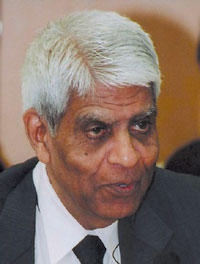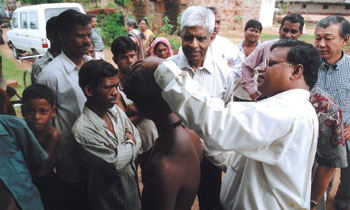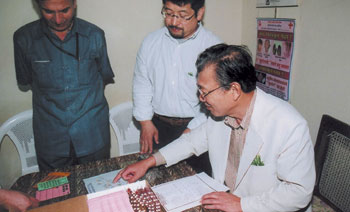Leprosy Elimination-Progress and Prospects
Dr. S.K. Noordeen |
 |
| |
With under two years until the World Health Assembly target date for the elimination of leprosy by the end of 2005, Dr. S.K. Noordeen looks at what has been achieved so far-and what still needs to be done.
Progress toward elimination of leprosy in the last two decades has been phenomenal. This has largely been attributable to two factors−the development of multidrug therapy (MDT) and its implementation on a wide scale, and the commitment of leprosy-endemic countries to eliminate leprosy as a public health problem as reflected in the World Health Assembly resolution of May 1991.
The World Health Assembly resolution was largely the result of the recognition of the tremendous potential of MDT and the worldwide interest in trying to see the end, at least in public health terms, of a disease crippling millions of individuals.
MDT as recommended by WHO has proved to be therapeutically highly effective in curing leprosy. Cure rates have been close to 100%. Relapses have been extremely infrequent. Drug resistance has not been a problem. MDT acceptance levels have been very high.
The perception that leprosy can be cured through MDT has resulted in considerable reduction in social stigma attached to the disease. MDT implementation has also motivated health workers and has facilitated integration of leprosy work within the general health services. Above all, the effectiveness of MDT and its potential to contribute to elimination of the disease has enabled extraordinary donor support for free supply of MDT drugs to the patients.
Channeled through WHO, this support has enabled universal coverage for treatment of leprosy patients through standard high-quality drugs. Such visible ‘drug security’ has strongly contributed to the sustained commitment of national governments toward leprosy elimination. |
| |
| Prevalence Rates Down Significantly |
The overall global reduction in prevalence over the last 18 years has been very striking, with the disease burden coming down by 90% (5,369,000 cases in 1985 to 524,000 cases in 2003).
With regard to progress in the African continent, the results seen in several countries have been exceptional.
Between 1985 and 2003, the reduction of prevalence in Africa has been 95% (from 1,028,000 cases to 50,000 cases) while in other parts of the world (mainly Asia and the Americas) it has been slightly less at 89% (from 4,341,000 cases to 474,000 cases). Even in very high prevalence areas, the prevalence reduction has been steep.
However, there have been some exceptions, particularly in countries where medical service coverage has been quite poor and where the programs have been hampered due to civil disturbances. Even now, the leprosy situation is not entirely clear in a small number of countries affected by civil strife (e.g. Somalia, Democratic Republic of Congo, Sierra Leone and Liberia).
Looking at what has been achieved in the past year, there has been a reduction of about 19% in both prevalence and new case detection globally. This has been contributed largely by India and Myanmar, where the reduction in prevalence has been 22% and 39%, respectively. In terms of new cases detected, the reduction in India has been about 23% and in Myanmar, 24%. If the progress made by India in the past year is maintained, then there is every possibility it will meet the elimination target set for 2005.
In other high-burden countries, progress has been less dramatic. The situation in Brazil continues to be unclear both in relation to prevalence and case detection, and is in urgent need of clarification. However, the overall trend there is toward steady reduction in the number of advanced cases, cases with deformity and cases among children. |
| |
| Patchy Geographic Coverage |
| The continuing problem in achieving leprosy elimination in certain areas is mainly one of coverage. Even now in a number of countries, health services coverage is relatively poor. This means that leprosy patients can only be reached through special campaigns. |
| |
 |
| Dr. S.K. Noordeen (center) seen with Orissa Assistant State Leprosy Officer Dr. P.K.B Patnaik (right) and Ambassador Sasakawa (far right) during a visit to a village in Orissa. |
| |
Plus, even in areas where health services coverage is reportedly high, access to leprosy services remains far from satisfactory. Service providers are not sufficiently proactive and awareness about the disease and its curability is quite low.
This is seen in the trend of leprosy in a number of high-burden countries. While prevalence reduction was very rapid in the initial years after reaching high MDT coverage, the rate of decrease has slowed down considerably in recent years.
New cases continue to be detected, mainly from areas where MDT had been introduced more recently. New cases are also being detected in other areas in significant numbers, due to such reasons as re-registration of old patients and over-diagnosis of leprosy among individuals with only doubtful evidence of the disease, both resulting from the pressure to maintain high levels of case detection. |
| |
| Sustained Interest Needed |
Achieving leprosy elimination will depend upon the following factors: sustained interest, advocacy and political commitment at the global, regional and national levels; strengthened support by partners; and the continued intensification of the integration of leprosy work within the mainstream of general health services.
This should make it possible to ensure that all or nearly all leprosy patients are identified in time and treated with MDT, and that patients are accepted within their communities.
In some areas, leprosy elimination may take longer, in spite of the best efforts being made. This is largely a result of the late start of MDT implementation, unusually high prevalence levels to begin with, and certain unknown epidemiological factors. However, this is likely to apply only in certain limited areas and not likely to influence the global picture. |
| |
 |
| Checking MDT at a Primary Health Center in Nagpur, Maharashtra |
| |
Thus the overall prospects for reaching the leprosy elimination goal appear to be quite bright provided we continue to sustain our commitment, identify problem areas and situations and intensify our efforts as required.
Dr.S.K.Noordeen is former WHO Director for the Action Program on the Elimination of Leprosy and Chairman of the Leprosy Elimination Alliance, Chennai, India |
|